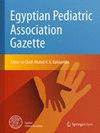Predictors of persistent asthma among preschooler wheezers: a retrospective case series study
IF 0.5
Q4 PEDIATRICS
引用次数: 0
Abstract
Early childhood wheezing can evolve to different asthma phenotypes. Prediction of persistent asthma during the preschool years has proven challenging. Through this study, we aimed to identify predictors of persistent asthma in preschooler wheezers. This was a retrospective case series study over 10 years. Patient data from 98 infants diagnosed with infantile asthma were obtained from their medical records. A multivariate logistic regression model was developed to determine predictors of persistent asthma in preschooler wheezers. The sex ratio was 1.72. The mean age at the first episode of wheezing was 7 ± 3.17 months. The mean age at diagnosis was 14.82 ± 4.28. Asthma was well controlled in 71 cases (72.44%) and partly controlled in 27 cases (27.56%). Two groups were identified: transient wheezers (61.33%) and persistent wheezers beyond the age of 5 years old (38.77%). The average age for wheezing disappearance was 24.28 ± 4.1 months. Four predictive factors for persistent asthma were identified: familial atopy (adjusted odds ratio [OR] 4.76; 95% confidence interval [CI] 2.52–12.45; p < 0.001), passive smoking (adjusted OR 5.98; 95% CI 2.48–13.64; p < 0.001), poor control of asthma (adjusted OR 5.23; 95% CI 2.47–14.76; p 0.0013), and aerosensitization (adjusted OR 7.38; 95%CI 3.87–17.84; p < 0.001). The main predictors for persistent asthma among preschooler wheezers were aerosensitization, family history of atopy, early exposure to passive smoking, and poor control of asthma. The detection of such factors allows for earlier diagnosis and targeted prevention strategies.学龄前喘息儿童持续性哮喘的预测因素:回顾性病例系列研究
儿童早期喘息可演变成不同的哮喘表型。事实证明,预测学龄前儿童的持续性哮喘具有挑战性。通过这项研究,我们旨在确定学龄前喘息儿童持续性哮喘的预测因素。这是一项超过10年的回顾性病例系列研究。从98名诊断为婴儿哮喘的婴儿的医疗记录中获得患者数据。建立多变量logistic回归模型以确定学龄前喘息儿童持续性哮喘的预测因素。性别比为1.72。首次发作的平均年龄为7±3.17个月。平均诊断年龄为14.82±4.28岁。哮喘控制良好71例(72.44%),部分控制27例(27.56%)。分为两组:短暂喘息(61.33%)和5岁以上持续喘息(38.77%)。喘息消失的平均年龄为24.28±4.1个月。确定了持续性哮喘的四个预测因素:家族性特应性(校正优势比[OR] 4.76;95%置信区间[CI] 2.52 ~ 12.45;p < 0.001),被动吸烟(调整OR 5.98;95% ci 2.48-13.64;p < 0.001),哮喘控制不良(调整OR 5.23;95% ci 2.47-14.76;p 0.0013)和气敏化(调整OR 7.38;95%可信区间3.87 - -17.84;p < 0.001)。学龄前喘息儿童持续性哮喘的主要预测因素为气敏化、特应性家族史、早期被动吸烟和哮喘控制不良。这些因素的发现有助于早期诊断和有针对性的预防战略。
本文章由计算机程序翻译,如有差异,请以英文原文为准。
求助全文
约1分钟内获得全文
求助全文
来源期刊

Egyptian Pediatric Association Gazette
PEDIATRICS-
自引率
0.00%
发文量
32
审稿时长
9 weeks
期刊介绍:
The Gazette is the official journal of the Egyptian Pediatric Association. The main purpose of the Gazette is to provide a place for the publication of high-quality papers documenting recent advances and new developments in both pediatrics and pediatric surgery in clinical and experimental settings. An equally important purpose of the Gazette is to publish local and regional issues related to children and child care. The Gazette welcomes original papers, review articles, case reports and short communications as well as short technical reports. Papers submitted to the Gazette are peer-reviewed by a large review board. The Gazette also offers CME quizzes, credits for which can be claimed from either the EPA website or the EPA headquarters. Fields of interest: all aspects of pediatrics, pediatric surgery, child health and child care. The Gazette complies with the Uniform Requirements for Manuscripts submitted to biomedical journals as recommended by the International Committee of Medical Journal Editors (ICMJE).
 求助内容:
求助内容: 应助结果提醒方式:
应助结果提醒方式:


